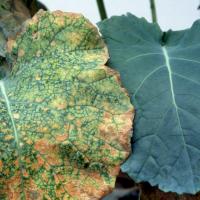Diagnosing boron deficiency in canola
Boron deficiency is rare in most crops sown in Western Australia. However boron deficiency is likely to impact broadleaf crops such as lupin and canola before cereals.
What to look for
- Bunchy young plants with convex cupped mottled and discoloured leaves with worse symptoms on acidic sandy soils during extended dry periods
- Flowering plants with flower abortion and extended flowering and abortion from side branches, particularly in extended dry weather
Paddock
- Young plants have shortened, possibly cracked stems and deformed leaves that cup outwards and thicken making them brittle.
- The emerging leaf is red-brown to purple, and unfolded leaves have pale interveinal blotching.
- Interveinal necrotic spots and the leaf dies inwards from leaf edges to veins.
- The growing point may die and be replaced by lateral branches when soil moisture increases.
- Flowers form but abort, with side branches producing more flowers that abort or set pods according to boron availability.
Plant
What else could it be
| Condition | Similarities | Differences |
|---|---|---|
| Diagnosing glyphosate damage in canola | Growing point death, stunted plants, discoloured leaves. | Boron deficient plants do not die, they have less distorted leaves and are symptoms are worse on acidic sandy soils. |
| Diagnosing group B herbicide damage in canola | Growing point death, stunted plants, discoloured leaves. | Boron deficient plants do not die, they have less distorted leaves and are symptoms are worse on acidic sandy soils. |
Where does it occur?

Soil type
- Areas most at risk of boron deficiency are sandy acidic sedimentary soils on the west coast that receive more than 600 mm annual rainfall - such as the sand plains of the Dandaragan plateau stretching from the West Midlands to the Eradu sandplain.
Management strategies

Spraying foliar

Spreading lime
- Soil or foliar applications of boron
- Foliar applications act rapidly but timing of application is important to avoid irreversible damage
- Soil applications generally last longer but can be leached from acidic, sandy soils. Be careful to avoid higher rates than necessary as these can cause boron toxicity in plants.
- Liming increases soil boron availability.
How can it be monitored?

Tissue test
- Guideline critical whole plant levels range from 22 (seedling) to 15 (rosette) mg/kg. As boron is immobile in the plant, young shoot sampling is most accurate.
- Critical levels at the seedling stage are not reliable because dry or acidic topsoil will reduce boron availability. and as boron moves through the soil higher levels may be present in the subsoil.
- There is no calibrated soil test for boron deficiency in canola. Soil testing may be useful on deep sands but on duplex soils subsoil boron levels should also be determined.
See also
Further information
Where to go for expert help
Page last updated: Wednesday, 6 May 2015 - 11:35am





